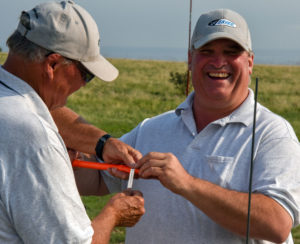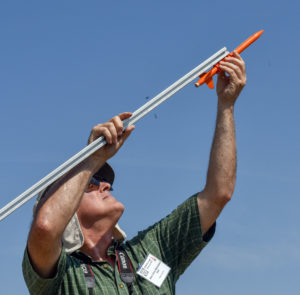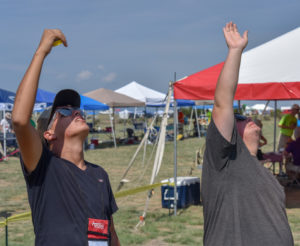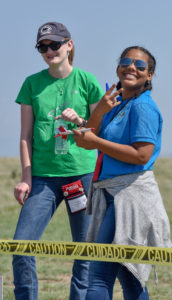Competition Strategy

Constant 1: Have FUN!
The most important thing to remember about NAR competition is that model rocketry should be FUN! Any activity that you choose for a hobby should be more relaxing and entertaining than frustrating. If you are not having fun, then stop; take a few deep breaths and remind yourself that this is JUST A HOBBY! Anytime you have a question or concern, ask a fellow rocketeer. A model rocket contest is not a contentious affair. You’ll find that the people with whom you are competing will bend over backwards to help you. They will freely share their ‘secrets’ and I have often seen them swap supplies or donate items that might be used to beat them.
Constant 2: Know the Rules
Obviously, being prepared and organized will help you in flying in a model rocket contest. Building and practicing with properly designed models is a good first step. The only way to do this is to know the rules. US Model Rocket Sporting Code. Each event has its own set of special requirements concerning such things as construction, catching the model, and number of allowed or required flights. Feel free to ask questions. Contact other rocketeers, your local NAR Section, or NAR HQ.
 Constant 3: Be Prepared
Constant 3: Be Prepared
“Be Prepared” is not just the Boy Scout motto. Itis a necessity for model rocket competition. You want to make sure you have all the parts, equipment and supplies you need. This will depend on the events you enter. Regardless of the events you enter, however, your preparation will be governed by what I call the Four Rs.
- Reliability. There are no points for disqualified flights. Enter rockets that you have flown successfully before. For many eventsyou’ll be able find a commercial kit that is suitable. Make sure the recovery system will function properly and that the motor will stay where it is supposed to. Flying unproven designs at a contest is asking for trouble. High tech, cutting edge designs are often beaten by more reliable models of lower performance that function as designed. If you choose to follow the ‘Edge of the Envelope” path, plan ahead and make time for practice flights to prove your models.
- Return. Be certain you understand the rules of each event you enter. Some events require that each flight be returned. Some require that one flight be returned. Some have no return requirement. You must recover the model in order to set a national record. Be prepared to recover your models. Wear appropriate clothing, bring FRS radios, arrange for a ‘ground crew’ to help, make sure that you have a good view of the model when it reaches the ground. Take drinking water with you, especially if the climate is hot and dry.
- Redundancy. Try to have more than one rocket for each event you enter. If the flying field is small or the weather is less than optimal, you may need to use models that don’t perform as well as your best birds. Be prepared with models and motors that offer low and high performance options. Come prepared with different sizes of parachutes and streamers.
- Repetition. Most events allow two flights. Many events sum the performance of both flights to determine scoring. Understand the scoring and be prepared to make repeat flights. Be sure you have enough motors, models and other supplies of the right type and allow time for multiple flights.
 Competition Tactics: Design, Build, Fly
Competition Tactics: Design, Build, Fly
Competition tactics involves exactly how you design, build, and fly your models. In general, you should try to achieve the highest possible performance while still meeting the event requirements. This means your rockets should go as high as possible and still deploy the parachute, streamer, glider, rotors, etc. Gliders should go as high as possible, but that have to survive boost and then transition to glide. Helicopter models should go as high as possible but have to deploy their rotors and auto rotate. Egg Lofters should go as high as possible but must return the egg unbroken. Here are some tactics to consider:
- The biggest factors in altitude performance that you can control are weight, body diameter (frontal area) and good construction. You’ll do better in almost all USMRSC events by minimizing weight and frontal area while ensuring that the fins are on straight and have a uniform airfoil.
- You can further reduce aerodynamic drag by using only three fins and launching from a tower or piston launcher instead of using a rod.
- Your model will have less drag with a good finish than with a poor one. Using too much paint adds weight that could offset the effect of the smooth finish.
- For duration events, use a minimum diameter body tube and the largest/most efficient recovery system that will reliably deploy properly. Sometimes this will mean using the smallest possible motor and body tube diameter to get the most altitude. Egg Loft duration, however, already requires a large body diameter. One caveat here – younger competitors can more easily pack parachutes and streamers into larger-than-minimum body tubes.
- For altitude events, using minimum diameter and weight will usually achieve the highest altitude. Use a program such as wRASP or RocSim to verify your choice of delay time and launch weight. While the optimum weight for most model rockets is as light as possible, in some cases with C and larger motors you may have to add weight to get the most altitude. Usually you’ll use a small recovery system in order to minimize duration and make recovery easier. Remember that the model must be TRACKED to place. If it is too small or not visible enough you will have problems.
- Fly the weather and fly the field. If it’s windy, if the field is small or has hazards, consider using a smaller recovery system or lower performance rocket or glider.
 Beyond the Basics: Go For It!
Beyond the Basics: Go For It!
In the long run, you will probably garner more points by consistently placing (earning 1st, 2nd, 3rd or 4th) than by making an all out maximum performance effort. However, after you’ve gained some experience in competition, you may want to push the envelope. You can experiment with various combinations of altitude and hang time for duration events. Consider using a piston launcher or other exotic launchers. Build more than one model for each event in the contest. Use a go-for-broke, maximum performance bird for your first flight. Use a reliable, sure-fire, positive return model to get a qualified flight on your second flight, if return is required. Always have backups. Bring different sizes of parachutes and streamers. Build different sizes of gliders. Exotic building techniques offer many advantages and challenges. Try rolling your own body tubes from vellum or fiberglass. Streamline your models to have the smallest possible base diameter, thus reducing base drag. You have to decide how much time, money and effort you can expend. Most of all, you have to remember to HAVE FUN!